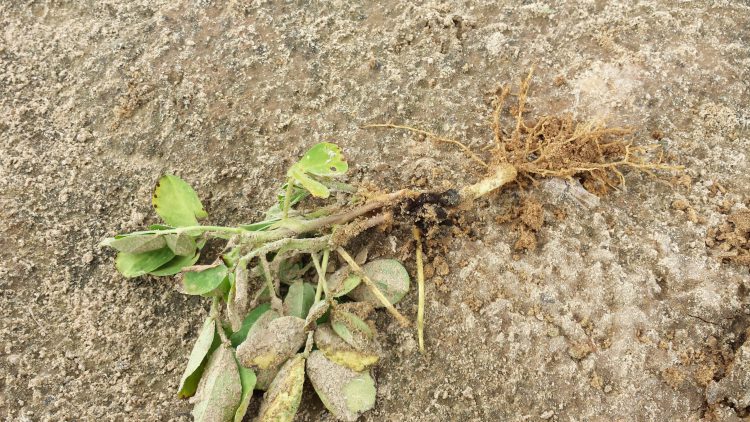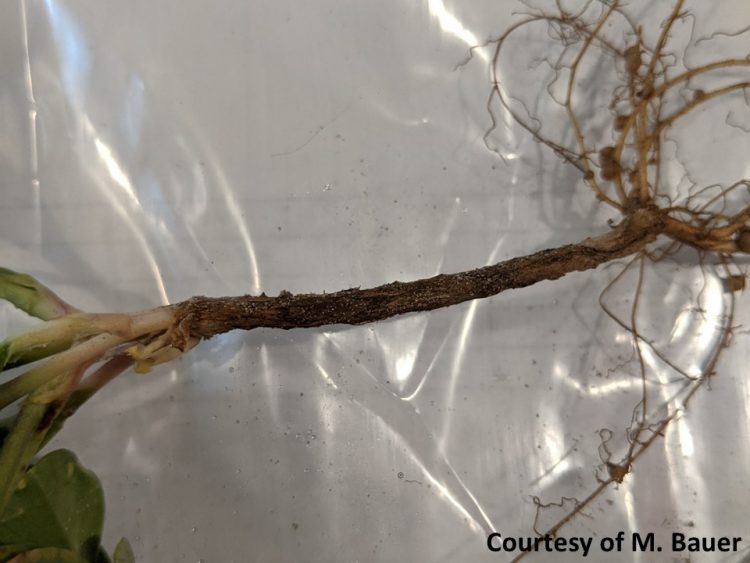There are many environmental, chemical, and biological factors that can affect a peanut stand; fungal diseases being one of them. Recently, Aspergillus species have been the focus of fungal problems on peanut seed, as well as stand issues in the field (Aspergillus crown rot). But what about when a stand disease issue is not caused by Aspergillus? Does it change how you manage it?
Besides Aspergillus, we have three main fungi that can cause seedling diseases: Cylindrocladium, Pythium, and Rhizoctonia. Typically, seed treatments (Dynasty® PD and Rancona® V PD) should reduce the presence of these diseases, but when we have a low germination rate from seed, or planting was not optimal (e.g. drought conditions or planting too deep), they can become a problem. In particular, Rhizoctonia crown rot has been a problem for Florida peanuts in the past, and has been a common issue for slow germinating or slow growing peanuts. While there is not much that can be done for Rhizoctonia crown rot this year, it is important to identify the pathogen for future disease management.
–
Crown rots

Figure 1 Example of the black spores that develop on the crown of peanuts, caused by Aspergillus niger
How can you tell the difference between Aspergillus and Rhizoctonia crown rots? It is not easy to tell the difference between the two diseases without having some fungal structures present. The Aspergillus crown rot fungus produces black spores that can be seen with or without a hand lens on the peanut crown (Fig. 1). On the other hand, Rhizoctonia does not produce spores and needs to be examined in the lab (Fig. 2 below). It is not uncommon to have both pathogens present too, which can complicate diagnosis. It is recommended that a sample be submitted to a diagnostic lab.
–
Rhizoctonia Management
If you find Rhizoctonia crown rot to be a problem, especially in the absence of Aspergillus crown rot, then there are a few things to consider for future management.
-
Rotate peanuts with a grass crop to reduce Rhizoctonia populations.
-
Avoid planting in non-optimal conditions (e.g. drought, too deep, temps < 68°F)
-
Choose varieties that germinate quickly and uniformly
-
In-furrow application of azoxystrobin# (e.g. Abound®) should provide quality (very good*) Rhizoctonia management
-
# The utility of Abound for controlling Aspergillus crown rot has decreased with the identification of genes known to cause fungicide resistance.
-
-
In-furrow application of Proline® should provide useful (good*) Rhizoctonia management
-
* Ratings are based on soybean seed treatment efficacy data from Wisconsin
-
–
Summing Up
There are multiple fungi that can cause seedling problems with peanuts. It is important to know which pathogens are present, as it can impact your future disease management program. This is especially important when we see shifts either in fungicide usage (as with Rancona), or the identification of fungicide resistance (as with azoxystrobin and Aspergillus). Any growers with stand issues are strongly encouraged to contact their local County Extension Agent and consider submitting a sample to a Plant Disease Clinic.
- 2025 End-of-Season Florida Peanut Disease Notes - October 24, 2025
- Southern Rust Confirmed in the Florida Panhandle – June 2025 - June 6, 2025
- Stay Ahead of Disease with the Spore Report: A New Tool to Assist with Potato and Watermelon Management - April 11, 2025

